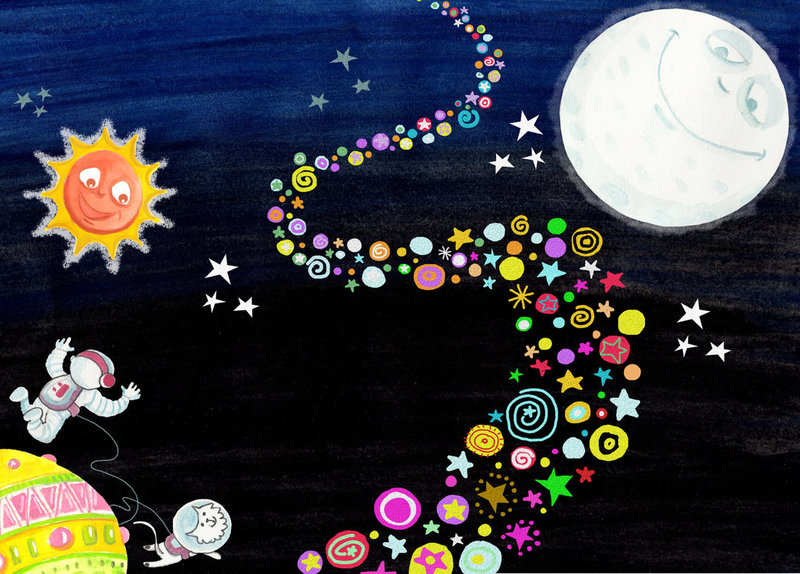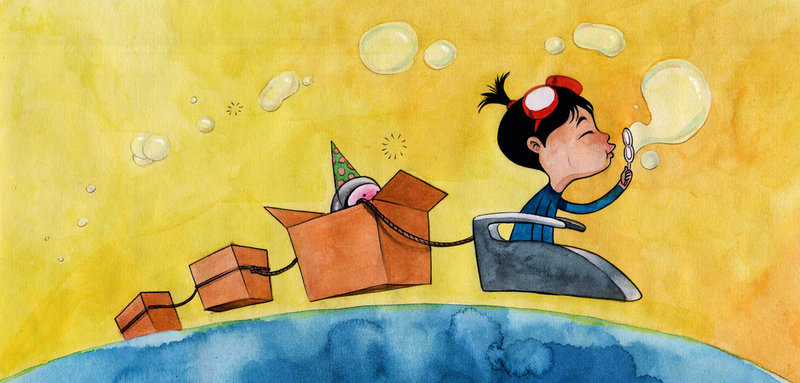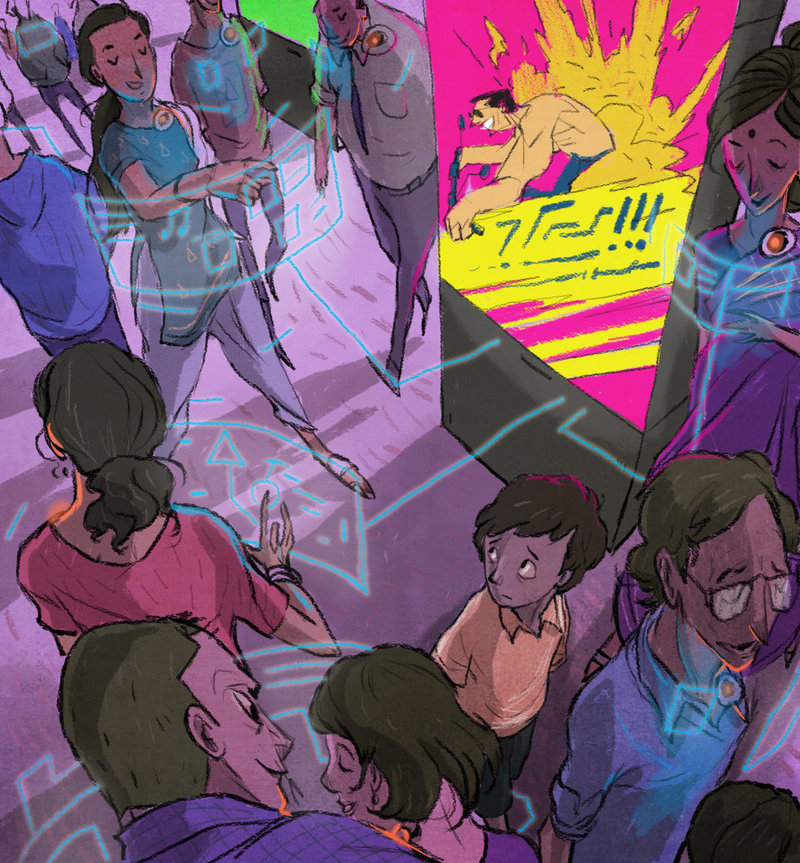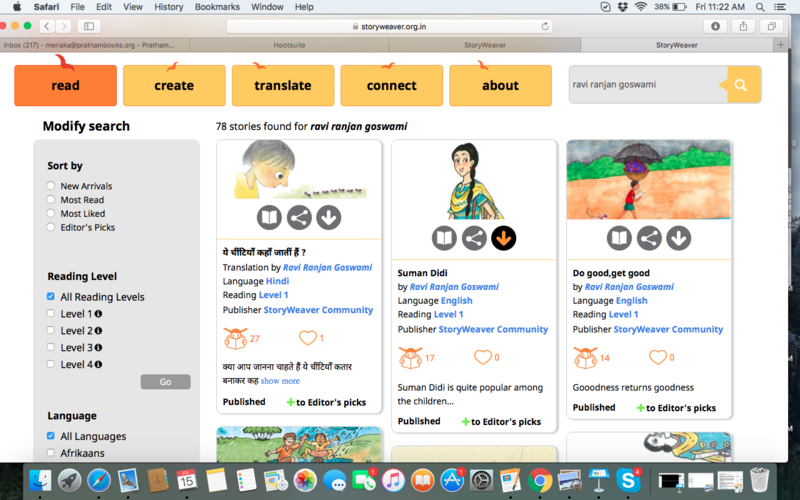In conversation with writer, editor Payal Dhar
Posted by Remya Padmadas on July 04, 2017Payal Dhar is a writer and editor. She writes on computers, technology, books, reading, games and travel, and has written on sport in the past. She also writes fiction for children and young adults, and has a number of books under her belt. You can read more about her on her website: http://writeside.net. Payal edited a number of titles from our set of STEM books, and we caught up with her about her experience.
You commissioned and edited picture books that explored science, technology and engineering topics. As an Editor, how did you make these stories appealing for early readers?
Well, it’s probably fairer to say that we tried our best to make them appealing for young readers—whether we succeeded or not is quite another story. I was lucky to be able to entice a bunch of enthusiastic, eperienced and talented writers to work with, who understood what we were trying to achieve and were fully on board with it. That really made my work easy. The illustrators also played their role in making the stories well rounded and entertaining. I think that what we were all (writers, illustrators, editors and you good folks at StoryWeaver) completely clear about from the start was what we didn’t want, that is, no lessons disguised as stories. The rest was (relatively) easy.

What did you enjoy most about the process?
Figuring out a way to stick to a subject or broad theme without being that aforementioned lesson-disguised-as-story. The ones I enjoyed most were what I call the ‘fictionalised non-fiction’, especially Roopa Pai’s Bonda and Devi, Anil Menon’s Manikantan Has Enough and Richa Jha’s Gul in Space.

What were the challenges?
In the first year of commissioning I did struggle with finding a balance between keeping things simple and not making them simplistic because of the particular demographic that Pratham Books caters to. I couldn’t exactly say that I’ve figured it out since, but it has certainly become a bit clearer. The other challenge, of course, that always crops up in projects of this sort, was dealing with difficult authors. But that was a very small minority, so no blood was shed. :)

Which are your favourite STEM books for children?
Among others, Esther Porter’s Peeking under the City; the Nick and Tesla books by Bob Pflugfelder; and David Macaulay’s The Way Things Work.
The books that you’ve worked on are so diverse in themes, style and structure. Tell us a little about working with so many different writers and your approach as an editor.
I was pretty privileged in working with writers who were already pretty experienced—you could say I had it easy in that regard—so there was little or no hand-holding required. Most of the writers understood the brief immediately and came up with brilliant ideas of their own. Most of them were able to self-reflect and improve on their own work as well, and this was critical in the revisions. All in all, despite a few roadblocks, I had a pretty uncomplicated time of it.
Read our STEM titles in English and a range of Indian languages for free on StoryWeaver.
Be the first to comment.Death of a Language is Death of a Culture
Posted by Remya Padmadas on December 27, 2016
Sahitya Akademi Award winner for his novel ‘Karmelin' and also, the recipient of the Vimala V. Pai Vishwa Konkani Sahitya Puraskar award for his novella 'Tsunami Simon', Damodar Mauzo is a novelist, a short story writer, a critic and a script writer. His collection of stories ‘Teresa’s Man’ was nominated for Frank O' Connor International Award in 2015. Co-founder of Goa Art & Literature Festival and also a co-curator of the litfest, Damodar Mauzo, would perhaps, best introduce himself as an activist for Konkani. He has presided over the All India Konkani Sahitya Sammelan, a literary conference in 1985 and also, served as president of the Konkani Bhasha Mandal, Goa’s premier organisation endeavouring the promotion of language, literature and culture.
I am a bit worried over the vulnerability of my language, Konkani. Not that it is losing its vibrancy. Not because it faces any threat from globalization nor because the number of speakers is on decline. What worries me is intergenerational transmission process getting disrupted or halted.
In spite of the imposition of the Portuguese by the colonial regime by passing the Decree in 1684 to ban the use of Konkani even in speech, the language remained Lingua Franca, thanks to its speakers. Konkani has also survived the threat from the neighbouring language Marathi that had claimed it to be its dialect. The language has paid huge price for sustained existence. Today, Konkani is part of the Eighth Schedule of the Constitution and also is the Official Language of the state of Goa. With Jnanpith and Sahitya Akademi awards coming her way meritorious Konkani literature is being taken cognizance of nationally and internationally. Yet, when threat of extinction looms large on many leading languages, I do become apprehensive, not without grounds. The first scare I felt was in February 2010, when the last speaker of Bo language of Andaman islands, Boa Sr. died. Death of a language is the death of a culture. People the world over strive to safeguard their culture as their language is their identity. They have already taken a proactive stand to preserve their linguistic identity anticipating the hegemony of the English language in the wake of the Internet Era. Aware of the situation moving towards monolingual world UNESCO had started a project called Universal Networking Language (UNL), that would thwart the monopoly of one language. Vide UNL, the content in one language would be codified and then would be transferred into any desired language by decoding it. At some stage it was noticed that this project was not moving on at the behest of the perpetrators of domination of English. It was only when Japan, France and Germany raised their voice at this mischief that the project picked up momentum.
It is true that there are, the world over, around seven thousand spoken languages, over half of which are feared to die by the end of the present century. Of these about 2000 languages are seriously endangered as they have fewer than 1000 speakers. In India itself 191 languages are classified as vulnerable or endangered. 1961 Census of India recorded total number of languages as 1,652. However, 1971 Census eliminated many of them following the decision to ignore the languages with less than 10,000 speakers. Dr. Ganesh Devy of Peaple’s Linguistic Survey of India (PLSI) says, “As per the 2011 Census, there are about 122 languages spoken by more than 10,000 people. Of them 22 are the scheduled languages. Other than the 122 languages, the survey has come up with languages that are spoken by less than 10,000 people many from tribal areas, nomadic communities and from the interiors of north-eastern part of the country.” The PLSI is a rights-based movement, which sees language as crucial for the effective development of fragile communities and for stemming the erosion of India’s diverse, multilingual, and composite heritage.
For Konkani, the major jolt is the shift in the medium of instruction. People prefer to send their wards for primary education to either Marathi medium or the English. Marathi because it has been a tradition and English because it is trendy. Masses that follow the classes blindly believe that their wards will immensely benefit by this shift, not realizing that the ward will never master the OTHER language. A UNESCO report says, “In a situation where the medium of instruction in school is a language that is not spoken at home the problems of learning in an environment characterized by poverty are compounded, and the chances of drop-out increase correspondingly.” At yet another UN meet on the subject it was asserted that ‘states have an obligation to preserve and protect the child's cultural identity, as an essential element for his or her development.’ It is a proven fact that Mother tongue literacy classes improve students' writing and higher-order language skills in their first language. Research has shown that many of the skills learned in the native language can be transferred easily to the second language later. In this type of program, the native language classes do not teach academic subjects. The second-language classes are content-based, rather than grammar-based, so students learn all of their academic subjects in the second language. But obviously the words of wisdom go unattended. In Goa, the Government does not realize that by promoting English at the primary level it is depriving the students of mastering Konkani and of learning Hindi as well. Leaving the choice of medium of instruction to parents is a grave mistake. Parents can be given the choice of choosing the physician, not the medicine. Similarly, parents can be given the choice to choose which school their ward would go, not the medium of instruction.
Goa is fast turning into a city state with its fast pace urbanization. The common dream of the youth is to go abroad or aboard ship. Greener pastures woo them and hence they feel no need of the proficiency in Konkani. In view of this confusing situation, the second generation classes are seen moving away from the language of the soil. The natural transmission is therefore interrupted. Though teatr, the popular form of theatre, is vibrant in Goa, the masses are seen blindly following the classes that are in favour of English in public and at home.
Konkani is rich in vocabulary and idiom. Our speakers live in diaspora in four different states. Their dialects help enrich the language. The multiplicity of scripts is yet another hurdle that limits the readership though conscious attempts are on to adopt a common script. As compared to the rest of the languages included in the Eighth Shedule, Konkani is spoken by hardly 4 to 5 million people. So in relative terms, Konkani is more vulnerable than many other languages, unless mindful and premeditated efforts are made to reach out to those who are on the verge of losing her.
Be the first to comment.
मेरे बचपन से स्टोरीवीवर तक… ( एक संस्मरण )
Posted by Remya Padmadas on September 22, 2016
बचपन मैं सभी बच्चों की तरह मुझे भी कहानी सुनने का बड़ा शौक था। खुशकिस्मती से मुझे कहानी सुनाने के लिये घर में अनेक लोग थे जैसे दादा-दादी, माता-पिता, भाई-बहन। ननिहाल जाते तो वहाँ नाना-नानी, मामा, मौसी...। कहीं भी हम होते रात को किसी न किसी से कोई न कोई मज़ेदार कहानी(यां) सुनकर ही सोते। मैं जब थोड़ा बड़ा हुआ और पढ़ना सीख गया तो अखबार और पत्रिकाओं में बाल साहित्य पढ़ने लगा। इस तरह कहानियां पढ़ने-लिखने का शौक लगा।
स्कूल के दिनों में छुट्टियाँ खेलने कूदने और कोमिक्स, बाल पत्रिकाओं में छपने वाली कहानियाँ, कवितायें या बाल उपन्यास पढ़ने में बीतती थीं। नन्दन, लोटपोट, चंपक, चन्दामामा - कुछ नाम याद हैं। चंदामामा में कहानियों के साथ छपने वाले चित्र और कहानियाँ बेहद रोचक होते थे।
जब मैं झाँसी में कक्षा आठ में पढ़ता था एक दिन मैंने एक छोटी-सी कविता लिखी और भाई-बहनों को सुनायी। पहले उन्हें भरोसा नहीं हुआ की मैंने वह कविता लिखी है। उन्हें लगा कि झूठी शान दिखाने के लिये मैं किसी और की लिखी हुई कविता सुना रहा हूँ। मैंने उन्हें शपथ लेकर कहा तो माने और उन्होंने कविता की तारीफ की। वह कविता मैंने दैनिक जागरण के बाल मण्डल के संपादक को प्रकाशन के लिये भेज दी। संयोग से वह स्वीकृत हो गयी और कुछ दिन बाद प्रकाशित हो गयी। समाचार पत्र में छपी अपनी रचना को देखकर मुझे बड़ी प्रसन्नता हुई। परिवार और पड़ोस के लोगों ने भी तारीफ की और मेरा उत्साह बढ़ाया। फिर कभी-कभी मैं कविता, कहानी, लेख इत्यादि लिखने लगा। उनमें से कुछ स्कूल और कालेज की पत्रिकाओं और स्थानीय समाचार पत्रों में प्रकाशित हुए।
नौकरी में आने बाद व्यस्तता बढ़ी और वातावरण बदल गया जिससे मेरा पढ़ना-लिखना बहुत कम हो गया । फिर विवाह हुआ और एक पुत्री का पिता बना। मैं, मेरी पत्नी और पुत्री अब एकल परिवार की शक्ल में, घर से दूर, एक दूसरे शहर में थे। जब पुत्री थोड़ी बड़ी हुई तो मेरी कहानियों में पुनः रुचि हुई। मैंने उसके बचपन में उसे, अपने बचपन की कहानियाँ सुनायीं और कुछ अपनी कल्पना से पिरोकर नयी कहानियाँ भी बनायीं। उसे कहानियाँ सुनने में आनंद आता था और मुझे सुनाने में। फिर वो बड़ी हो गयी अब उसे कहानियाँ सुनाने की आवश्यकता नहीं रही।
कभी-कभी मैं लिखता रहा, लेकिन मैंने बाल साहित्य नहीं टटोला था। हाल ही में इन्टरनेट पर कुछ खोजते हुए मुझे https://storyweaver.org.in/ मिला तो मुझे आश्चर्यजनक प्रसन्नता हुई। यह बच्चों और बड़ों, दोनों के लिये, रुचिकर है, सुगम है और निःशुल्क है। इसने मुझे बच्चों की कहानियों की तरफ पुनः आकर्षित किया और मैंने कुछ कहानियाँ लिखीं। बड़ा अच्छा लगा जब अपनी हिन्दी कहानी का अंग्रेजी और तेलगु अनुवाद देखा। इस साइट पर बच्चे भी आसानी से अपनी कल्पना से चित्र सहित कहानियाँ लिख सकते हैं।
स्टोरीवीवर (https://storyweaver.org.in/) बच्चों के लिये बहुत उत्कृष्ट समाज सेवा का कार्य कर रहे हैं। मैं इन्हें बहुत बधाई और शुभकामनायें प्रेषित करता हूँ।

रवि रंजन गोस्वामी की बुनी हुई कहानियाँ पढ़ने के लिए यहाँ क्लिक कीजिए…
Be the first to comment.